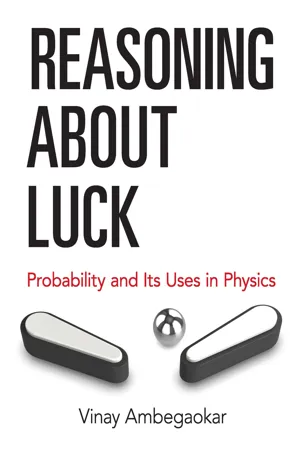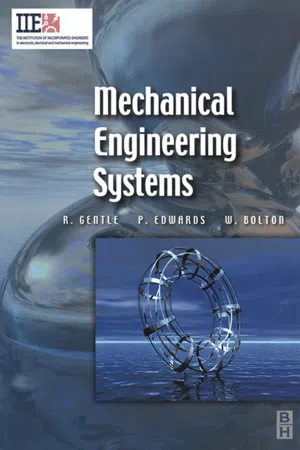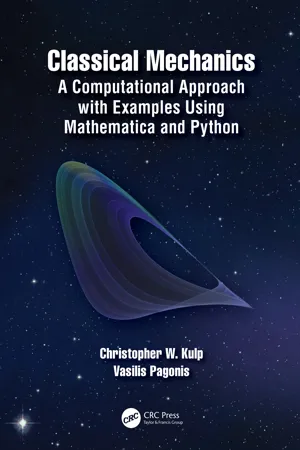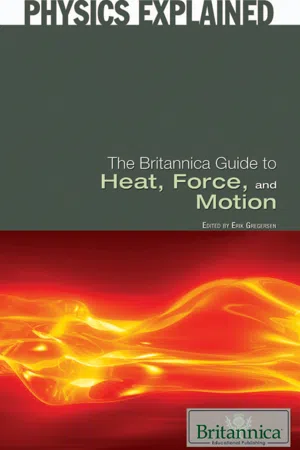Physics
Physics of Motion
The physics of motion deals with the study of the movement of objects and the forces that cause them to move. It encompasses concepts such as velocity, acceleration, and momentum, and is governed by Newton's laws of motion. Understanding the physics of motion is essential for explaining and predicting the behavior of objects in the physical world.
Written by Perlego with AI-assistance
Related key terms
6 Key excerpts on "Physics of Motion"
- eBook - ePub
- Vinay Ambegaokar(Author)
- 2017(Publication Date)
- Dover Publications(Publisher)
6
Forces, motion, and energy
... the whole burden of philosophy seems to consist in this – from the phenomena of motions to investigate the forces of nature, and then from these forces to demonstrate the other phenomena ... Isaac NewtonProbability enters theoretical physics in two important ways: in the theory of heat, which is a manifestation of the irregular motions of the microscopic constituents of matter; and, in quantum mechanics, where it plays the bizarre but, as far as we know, fundamental role already briefly mentioned in the discussion of radioactive decay.Before we can understand heat, we have to understand motion. What makes objects move, and how do they move? Isaac Newton, in the course of explaining the motion of planets and of things around us that we can see and feel with our unaided senses, answered these questions for such motions three centuries ago. The science he founded has come to be called classical or Newtonian mechanics, to distinguish it from quantum mechanics, the theory of motion in the atomic and sub-atomic world.Classical mechanics is summarized in Newton’s laws’ of motion. These will here be illustrated by an example involving the gravitational attraction, described by Newton’s ‘law’ of gravitation. In the brief description that follows, I shall attempt to show that these laws of nature: (i) unify apparently unrelated phenomena – like the motion of the moon and the fall of an apple; (ii) make simple but astonishing quantitative connections – between, for example, the rate of the moon’s revolution around the earth and the numerical value of the acceleration in an apple’s fall; and (iii), suggest new and useful concepts – here kinetic energy, potential energy, and, more generally, energy – which provide access to unexplored territory.To say that an object moves is to say that its position in space changes with time. This can only be given meaning by referring it to some fixed point. Imagine a straight line directed from such a fixed point to the place where our object is. This directed line is called the position ‘vector’ of the object. The word vector is used to indicate something that has a magnitude and a direction. We shall encounter other vector quantities soon. Two vectors are said to be equal when they have the same magnitude and - eBook - ePub
- Richard Gentle, Peter Edwards, William Bolton(Authors)
- 2001(Publication Date)
- Newnes(Publisher)
4Dynamics
SummaryThis chapter deals with movement. In the first part the movement is considered without taking into account any forces. This is a subject called kinematics and it is important for analysing the motion of vehicles, missiles and engineering components which move backwards and forwards, by dealing with displacement, speed, velocity and acceleration. These quantities are defined when we look at uniform motion in a straight line. This subject is extended to look at the particular case of motion under the action of gravity, including trajectories. This chapter also looks at how the equations of motion in a straight line can be adapted to angular motion. Finally in the first half the subject of relative velocity is covered as this is very useful in understanding the movement of the individual components in rotating machinery.In the second part of this chapter we consider the situation where there is a resultant force or moment on a body and so it starts to move or rotate. This topic is known as dynamics and the situation is described by Newton’s laws of motion. Once moving forces are involved, we need to look at the mechanical work that is being performed and so the chapter goes on to describe work, power and efficiency. Newton’s original work in this area of dynamics was concerned with something called momentum and so this idea is also pursued here, covering the principle of conservation of momentum. The chapter extends Newton’s laws and the principle of conservation of momentum to rotary motion, and includes a brief description of d’Alembert’s principle which allows a dynamic problem to be converted into a static problem. - eBook - ePub
Doing Physics with Scientific Notebook
A Problem Solving Approach
- Joseph Gallant(Author)
- 2012(Publication Date)
- Wiley(Publisher)
Chapter 5Newton’s Laws of Motion
In the previous chapters on kinematics, we described motion in a quantitative sense. Once we know an object’s acceleration, we can describe its motion in terms of position, velocity, and time. Knowing how its motion changes lets us calculate how far, how fast, and how long the object moves.Now we move to a branch of physics known as dynamics. Dynamics is the study of the effects of forces on an object’s motion. Dynamics explains changes in motion by relating the cause of the changes (forces) to the effect (acceleration). Newton’s Second Law provides the rule relating the acceleration to the net force.There are three ingredients to Newton’s Second Law: the object’s acceleration, mass, and the net force acting on it. As we discussed in Chapter 2, the object’s acceleration is the rate of change in its velocity. Mass is a property of the object that determines how much change the net force produces. An object’s mass tells you how difficult it is to change its velocity and how much matter it has.A force is a push or a pull that can cause changes in motion. Forces are vectors, so they have magnitude and direction. This is consistent with your experience. When you exert a force on something, two things matter: how hard you push or pull and which way. Often objects have more than one force acting on them. The net force acting on an object is the vector sum of all the forces acting on it.Newton’s First Law
Newton’s First Law tells us what happens when there is no net force acting on an object.Newton’s 1st Law: An object will remain in a state of rest or continue in motion at a constant velocity unless compelled to change by a non-zero net force.When there is no net force acting on the object, there is no change in the object’s velocity. If it is at rest, it remains at rest. If it is moving, it keeps moving at constant velocity. Since velocity is a vector, constant velocity means no change in both speed and direction. Motion at constant velocity is motion in a straight line at a constant speed. - eBook - ePub
Classical Mechanics
A Computational Approach with Examples Using Mathematica and Python
- Christopher W. Kulp, Vasilis Pagonis(Authors)
- 2020(Publication Date)
- CRC Press(Publisher)
We also know from everyday experiences that there is a direct linear relationship between force and acceleration. For example, a 4 N net force will cause a 1 kg object to accelerate 4 m/s 2. Of course, the acceleration is caused by the vector sum of the forces. When you hold your cell phone, you are exerting a force upwards that matches the downward force of gravity, hence the two forces are equal in magnitude but opposite in direction, and therefore, their sum is zero. Hence, the cell phone does not accelerate. We have now laid out all of the tools needed to describe and explain an object’s motion. Next, we will discuss the core topic of classical mechanics, Newton’s Laws of Motion, which will explain the role of force and mass in determining the motion of an object. 1.3 Newton’s Laws of Motion Isaac Newton (1642–1727) developed both calculus and the foundations for classical mechanics. Newton’s book, Philosophiae Naturalis Principia Mathematica (Mathematical Principles of Natural Philosophy) was published in 1687 and is considered to be one of the most important works in the history of modern science. In the Principia, Newton stated his three laws of motion. Newton’s laws of motion are vital tools that allow us not only to explain why objects move the way that they do, but they also provide us with a means of predicting an object’s motion. In classical mechanics, the importance of Newton’s laws cannot be overstated; they are worth committing to memory. As you solve problems in this book, ask yourself how Newton’s laws are involved in the setup and solution to each problem - eBook - ePub
- Britannica Educational Publishing, Erik Gregersen(Authors)
- 2010(Publication Date)
- Britannica Educational Publishing(Publisher)
CHAPTER 4 THE LAWS OF PARTICLE MOTIONT he applications of Newton’s laws are wide-ranging. They can explain the motion of a pebble falling to the ground, a pendulum swinging in a grandfather clock, or a planet orbiting a distant star.MOTION OF A PARTICLE IN ONE DIMENSION
The simplest problems in mechanics involve a particle moving in one dimension—in other words, on a line. Such problems include those of falling bodies and masses oscillating back and forth.UNIFORM MOTIONAccording to Newton’s first law (also known as the principle of inertia), a body with no net force acting on it will either remain at rest or continue to move with uniform speed in a straight line, according to its initial condition of motion. In fact, in classical Newtonian mechanics, there is no important distinction between rest and uniform motion in a straight line; they may be regarded as the same state of motion seen by different observers, one moving at the same velocity as the particle, the other moving at constant velocity with respect to the particle.Although the principle of inertia is the starting point and the fundamental assumption of classical mechanics, it is less than intuitively obvious to the untrained eye. In Aristotelian mechanics, and in ordinary experience, objects that are not being pushed tend to come to rest. The law of inertia was deduced by Galileo from his experiments with balls rolling down inclined planes.For Galileo, the principle of inertia was fundamental to his central scientific task: he had to explain how it is possible that if Earth is really spinning on its axis and orbiting the Sun we do not sense that motion. The principle of inertia helps to provide the answer: Since we are in motion together with Earth, and our natural tendency is to retain that motion, Earth appears to us to be at rest. Thus, the principle of inertia, far from being a statement of the obvious, was once a central issue of scientific contention. By the time Newton had sorted out all the details, it was possible to account accurately for the small deviations from this picture caused by the fact that the motion of Earth’s surface is not uniform motion in a straight line. In the Newtonian formulation, the common observation that bodies that are not pushed tend to come to rest is attributed to the fact that they have unbalanced forces acting on them, such as friction and air resistance. - eBook - ePub
- Peter Childs(Author)
- 2010(Publication Date)
- Butterworth-Heinemann(Publisher)
Chapter 2
Laws of Motion
The laws of motion that apply to solids are valid for all matter including liquids and gases. When considering flow involving circular or swirling motion the laws of motion serve as a useful starting point.2.1 Introduction
A principal difference between fluids and solids is that fluids distort without limit. For example, if a shear stress is applied to a fluid, as illustrated in Figure 2.1 , then layers of fluid particles will move relative to each other and the particles will not return to their original position if application of the shear force is stopped. Analysis of a fluid needs to take account of such distortions.Figure 2.1 Relative motion of one layer of fluid over another. If the force causing the motion is removed then the fluid particles will not return to their original positions.One of the pre-eminent historical methods for analysing motion that has been applied involves identifying specific particles or objects and following their path. This method follows Newton’s approach for particle motion and projectiles and is traditionally known as the Lagrangian formulation of particle mechanics. In this approach the position of a particle is the principal variable and particle velocity, and acceleration can be obtained by the first and second derivatives of the position vector. For example if x , y , z define the coordinates of the vector of a particle P , then the component velocities are given byux = dx/dt,uy = dy/dtanduz = dz/dt. The Lagrangian formulation is illustrated for the case of a particle P in Figure 2.2 .Figure 2.2 The Lagrangian formulation of particle mechanics for a particle P.An alternative approach is to identify fixed locations in space and analyse the motion of whatever fluid is in the fixed location at a particular time. This approach was developed by Euler (1755 , 1759 ). The fluid domain can be divided up in to a grid of coordinates as illustrated in Figure 2.3 . If x , y , z are the coordinates of a fixed location forming an Eulerian grid then dx/dt = 0 , dy/dt = 0 and dz/dt = 0
Index pages curate the most relevant extracts from our library of academic textbooks. They’ve been created using an in-house natural language model (NLM), each adding context and meaning to key research topics.





